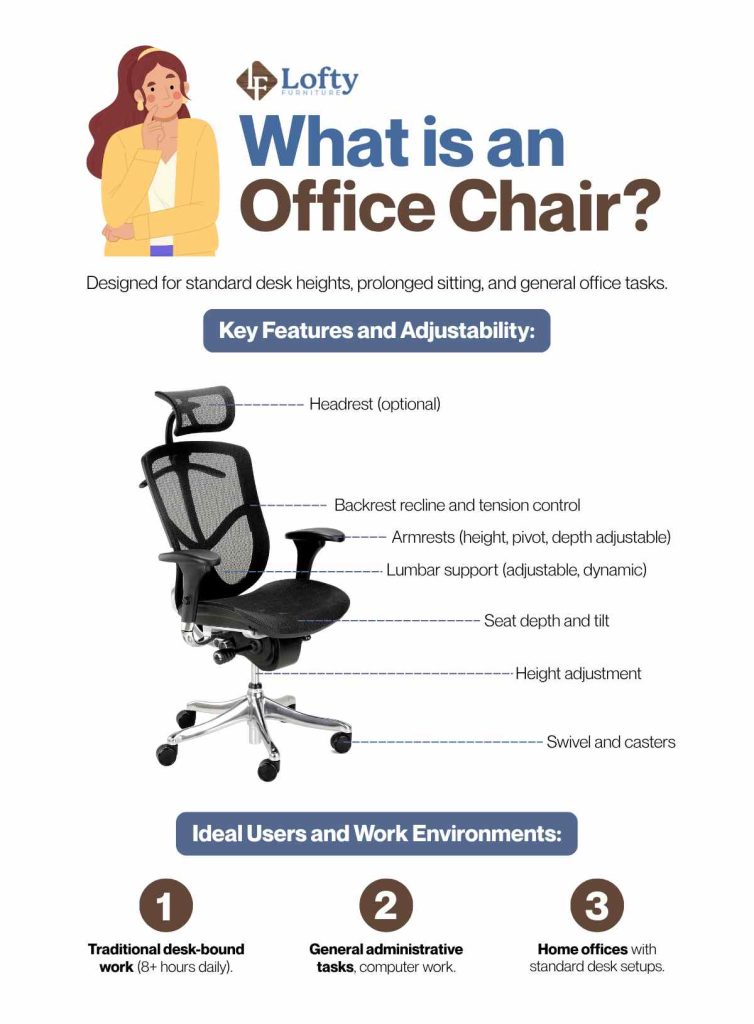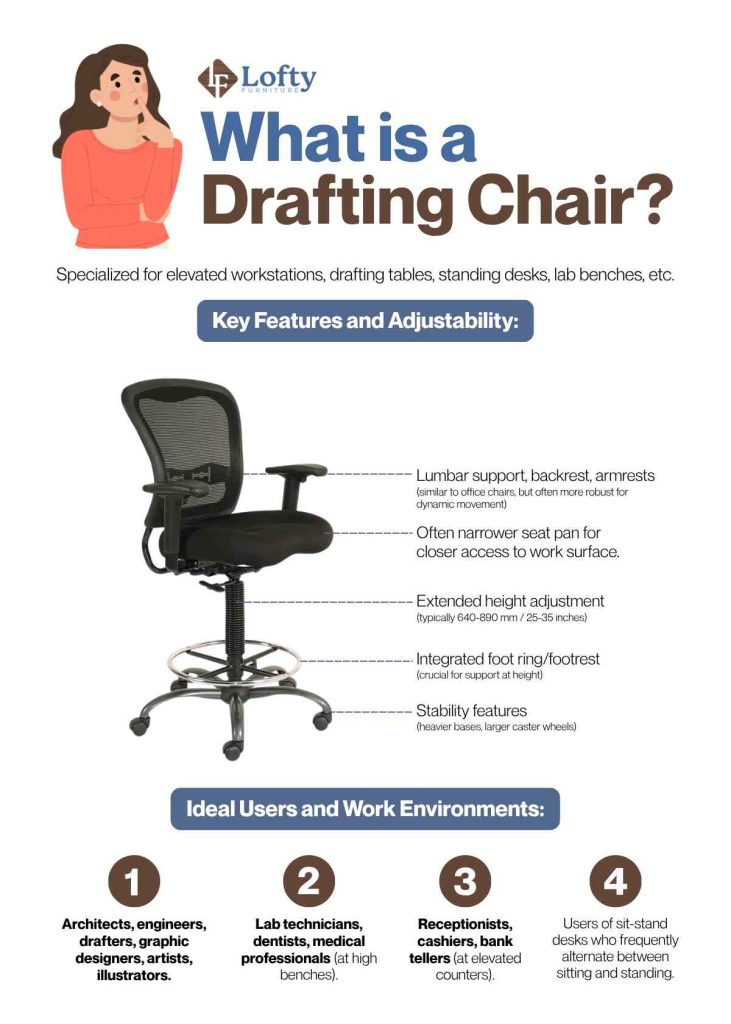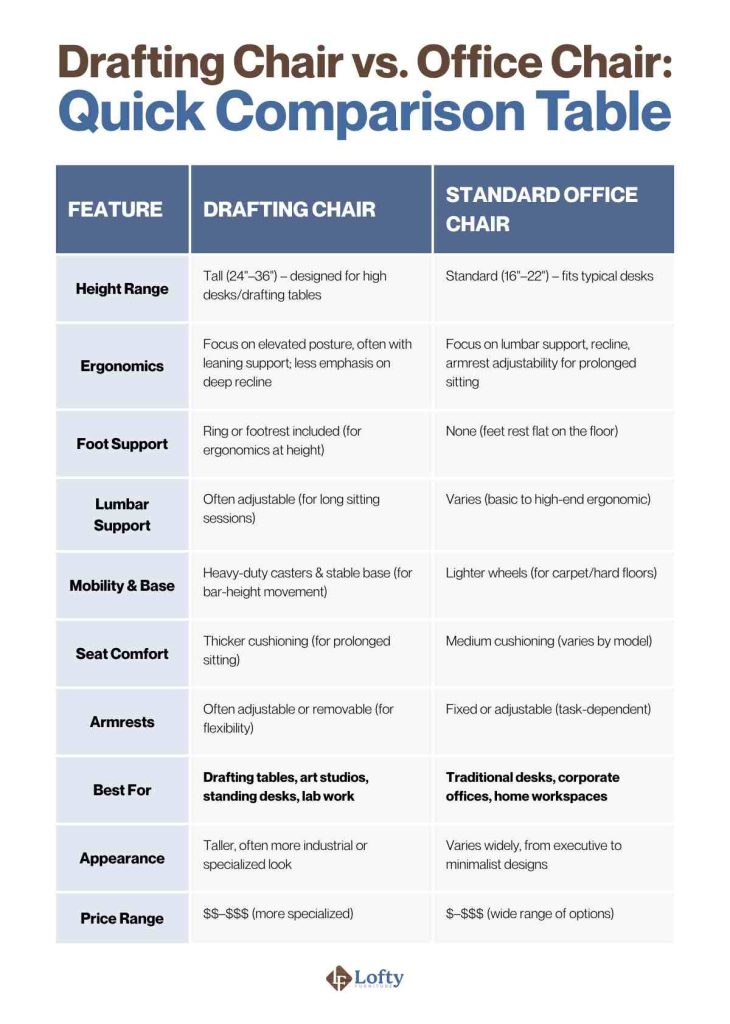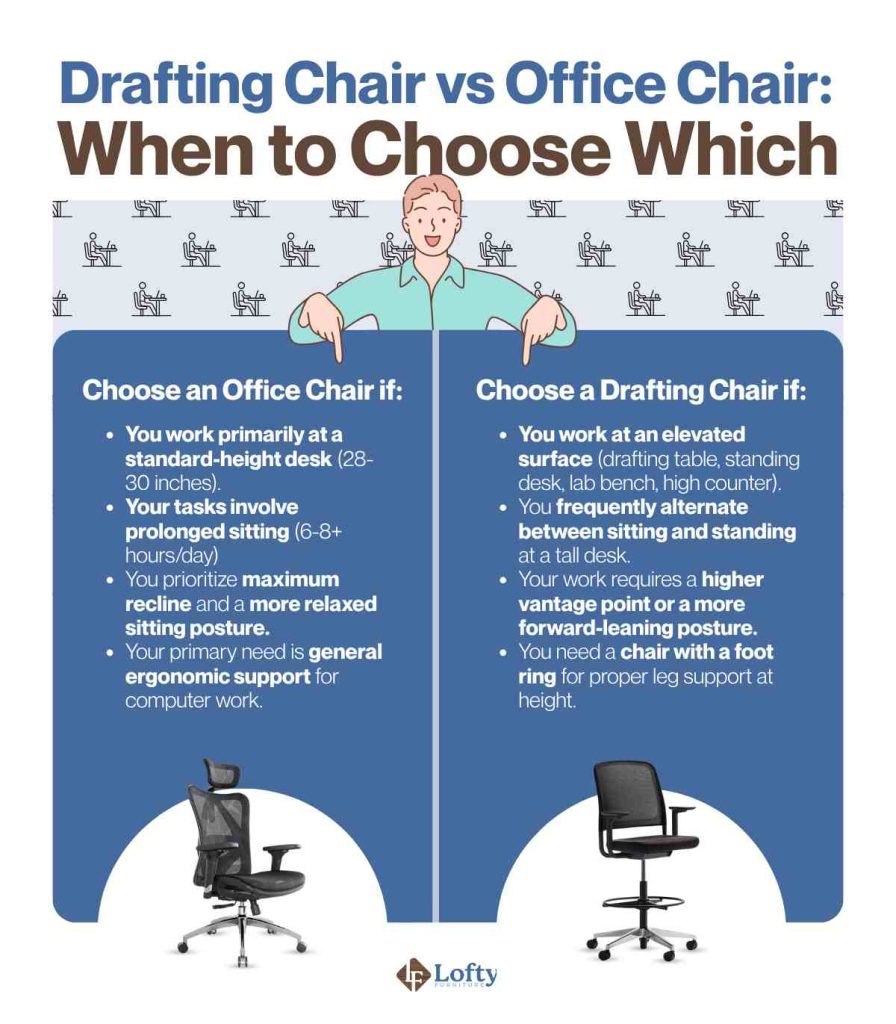When it comes to setting up a productive and comfortable workspace, the chair you choose isn’t just a detail—it’s a decision that can shape how you work day in and day out. Among the many options out there, two types stand out for very different reasons: the drafting chair vs office chair. Each serves its own purpose, caters to different working styles, and brings its own set of pros and cons to the table.
Key Takeaways:
- Choose a drafting chair if you work at a standing desk, elevated surface, or need flexibility between sitting and standing.
- Go with a standard office chair for traditional desks and long periods of seated work.
- Workstation height is the most important factor when deciding between the two.
- Both chair types can offer ergonomic features, but only if suited to your specific setup.
In this article, we’ll break down the key differences between drafting chairs and office chairs to help you decide which one best fits your needs. From ergonomics and adjustability to intended use and ideal environments, we’ll explore what sets each chair apart.
What are Standard Office Chairs?
Standard office chairs are the go-to choice for most traditional workspaces, and for good reason. As Matt Kelly, Senior Project Advisor of US Discount Office Furniture, notes:
“The lower center of gravity allows for more adjustability, customizable to user preferences, making them ideal for daily use.”
Designed with all-day comfort in mind, office chairs typically offer ergonomic support features like adjustable seat height, lumbar support, tilt mechanisms, and padded armrests. These elements are meant to promote good posture and reduce fatigue during long periods of desk work, contributing to the “enhanced health benefits of ergonomic features” highlighted by Kelly. This makes them ideal for tasks that involve extended computer use, writing, or meetings. Kelly also points out a “wider product selection to choose from to fit both style and functionality.” However, standard office chairs do have some limitations, like a lack of footrest.

What are Drafting Chairs
Drafting chairs are built for height and flexibility. Originally designed for architects and designers who work at elevated drafting tables, these chairs are ideal for workspaces where a standard office chair just won’t cut it. Drafting chairs often include ergonomic features similar to office chairs, such as lumbar support and adjustable armrests. This design allows users to maintain comfort even when working at standing desks, counter-height surfaces, or other elevated workstations. However, according to Kelly:
“Drafting chairs have limited adjustments aside from height variability and a more limited product selection compared to standard office chairs. For professions or setups that require that extra elevation, though, drafting chairs offer a smart and ergonomic solution.”

Ready to find the perfect pairing for your new drafting chair or office chair? Explore the versatility of an Amish grant sit-to-stand writer’s desk and elevate your workspace today!
Direct Comparison: Drafting Chair vs. Office Chair
Now, you might be wondering: What is the difference between office chair and drafting chair?
In a nutshell, drafting chairs are built for higher work surfaces like drafting tables or standing desks, offering extended height ranges and foot rings for support. Office chairs, on the other hand, are designed for standard desk heights and prioritize comfort for longer sitting sessions.

Here’s how they stack up across the key categories that matter for you:
Adjustability: Height, Lumbar Support & Armrests
Both chair types offer a range of adjustability, but the scale differs. Drafting chairs are designed to accommodate significantly taller workstations, with extended height ranges and a foot ring to support your legs at elevation. Office chairs, on the other hand, focus on fine-tuned comfort within a standard desk height range, often featuring more advanced lumbar support options and highly adjustable armrests.
Mobility, Comfort, and Long-Lasting Support
In terms of mobility and day-to-day comfort, both chairs offer rolling casters and padded seats, but comfort can feel different depending on use. Office chairs tend to prioritize plushness and support for all-day seated work while drafting chairs are more about balance and flexibility in active or standing desk environments. Over long periods, office chairs usually provide better-seated endurance.
💡 Pro Tip
💡 Pro Tip
If you switch frequently between seated and standing work, look for a drafting chair with a waterfall-edge seat design, which helps reduce pressure on the thighs and improves circulation during elevated sitting.
Design Aesthetics and Space-Saving Appeal
Standard office chairs are often more streamlined and can easily tuck under a desk, making them a natural fit for compact spaces or minimalistic office layouts. Drafting chairs, by contrast, are bulkier and stand taller, which can make them feel more prominent in a room. However, they do offer a modern, industrial look that suits creative studios and open-plan offices.
Budget-Friendly or Splurge-Worthy
When it comes to cost, both chair types can span a wide price range. Generally, drafting chairs can be slightly more expensive due to their added height mechanisms and foot support features. However, a high-end office chair with advanced adjustability and cushioning can easily match or exceed that price.

Drafting Chair vs Office Chair: Which One Should You Get?
Choosing between a standard office chair and a drafting chair ultimately depends on your specific work environment and habits. As Matt Kelly advises:
“For those sitting and working in one space (think cubicle, home office, or private office suite) for prolonged periods of time, we recommend a traditional office chair. Drafting chairs, however, may be a better choice for those in more dynamic roles, or for those who don’t find themselves sitting in one environment for prolonged periods of time.”
On the other hand, if you use a standing desk, work at a tall workstation, or often switch between sitting and standing in places like studios, labs, or team environments, a drafting chair provides the height and flexibility to support that kind of workflow. Ultimately, the right choice hinges on how—and where—you work most. Here’s a table to help you decide which chair is the right choice for your needs:

Conclusion: Choosing Between Drafting Chair vs Office Chair
At the end of the day, the right chair is about supporting the way you work. Drafting chairs and standard office chairs each bring unique strengths to different environments, and the best choice will come down to your desk height, task demands, and personal comfort. Investing in the right seating can make a meaningful difference in your posture, productivity, and overall well-being throughout the workday. By understanding what each chair offers, you’ll be better equipped to choose a solution that not only fits your setup but enhances it.
Frequently Asked Questions (FAQs)
Can you use a drafting chair at a regular desk?
Yes, many drafting chairs have adjustable height seats that let you lower them to work comfortably at a standard desk. Their ergonomic design, built-in footrests, and support features also make them suitable for a variety of tasks, from painting and drafting to everyday computer work.
Are drafting chairs good for your back?
Yes, many drafting chairs include adjustable backrests with lumbar support to help maintain the natural curve of your spine. This support is important for preventing back pain and encouraging good posture during extended periods of sitting.
How low do drafting chairs go?
Drafting chairs typically adjust lower than you might think—many can go down to around 22 to 26 inches in seat height. While standard drafting surfaces are about 37 inches high and office desks are closer to 30 inches, it’s important to check the chair’s range to ensure it can lower enough to keep you comfortable at your workspace.
